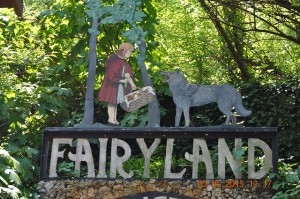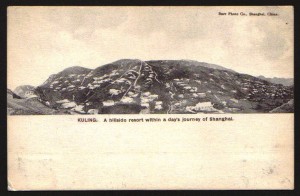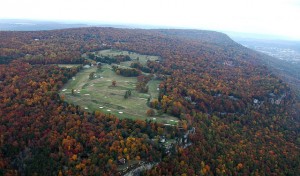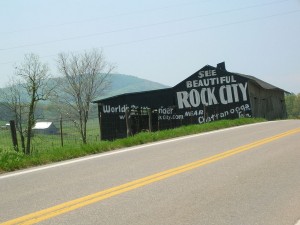Rock City is a timeless meeting place, with its rich and aesthetically beautiful geology attracting visitors from all over the world for several million years. Historical evidence shows that Native Americans first appreciated Rock City’s landscape while inhabiting Lookout Mountain. That is until 1823 when two missionaries, Daniel S. Butrick and William Chamberlain, arrived and spread word of the landscape’s potential for development. Revered Butrick noted in his diary that the area boasted “a citadel of rocks” that were arranged in a way “as to afford streets and lanes.”
 Traffic to the region increased through the Civil War, and people were beginning to spread word of this place commonly known as “Rock City.” However, it wasn’t until 1924 when Garnet Carter purchased the surrounding 700 acres that “See Rock City” culminated into the phenomenon it is today. Carter was a promoter by trade, and in 1924 he launched a new residential neighborhood on the top of Lookout Mountain known as “Fairyland.” One of the features of the new development to encourage visitors was a golf course, and due to slow construction, Carter accidentally created what is now recognized to be the nation’s first miniature golf course. With further development, Rock City officially became a public attraction and destination on May 21, 1932. With the help of creative advertising, the attraction now offers several other features, including the Fairyland Caverns and Mother Goose Village, the Cornerstone Station, and the Enchanted Garden of Lights during the holiday season.
Traffic to the region increased through the Civil War, and people were beginning to spread word of this place commonly known as “Rock City.” However, it wasn’t until 1924 when Garnet Carter purchased the surrounding 700 acres that “See Rock City” culminated into the phenomenon it is today. Carter was a promoter by trade, and in 1924 he launched a new residential neighborhood on the top of Lookout Mountain known as “Fairyland.” One of the features of the new development to encourage visitors was a golf course, and due to slow construction, Carter accidentally created what is now recognized to be the nation’s first miniature golf course. With further development, Rock City officially became a public attraction and destination on May 21, 1932. With the help of creative advertising, the attraction now offers several other features, including the Fairyland Caverns and Mother Goose Village, the Cornerstone Station, and the Enchanted Garden of Lights during the holiday season.
At the time of Rock City’s conception advertising campaigns did not yet have the grip on the nation that they now do. With money and reputation on the line, Garnet and Frieda Carter had to be creative to attract the masses to their new “fairyland” attraction. Garnet hired Clark Byers to travel the main roads of the 1930’s American countryside, offering farmers fresh paint jobs on their barns in exchange for permission to add “See Rock City” to the roofs of as many as would allow him. The strategy worked, and still today nearly 100 of the original 900 exist along country roads and highways alike from Michigan west to Texas and down into Georgia.
We drove through blocks of suburban houses on the top of Lookout Mountain. Professor Page explained how it was cooler on the Mountain and the houses had been used as summer resorts. These real estate developments completely changed the landscape of Lookout Mountain. Now the pristine scenery is there no more.  The mountain is “decorated” with pockets of houses. These neighborhoods reminded me of Mount Lu (LuShan) in Jiangxi, China. Since the weather in Mount Lu is cooler during the summer months, many famous Western missionaries in China acquired property in the Guling Estate on the mountain. Guling sits at the center between three peaks and is linked by mountain highway to neighboring places in the region. In a sea of clouds that encompass the mountain, Guling’s villas of diverse architectural styles from different countries formed an imaginary place and attracted visitors. Later, it even became “summer capital” and political leaders came there to spend summers and held important meetings.
The mountain is “decorated” with pockets of houses. These neighborhoods reminded me of Mount Lu (LuShan) in Jiangxi, China. Since the weather in Mount Lu is cooler during the summer months, many famous Western missionaries in China acquired property in the Guling Estate on the mountain. Guling sits at the center between three peaks and is linked by mountain highway to neighboring places in the region. In a sea of clouds that encompass the mountain, Guling’s villas of diverse architectural styles from different countries formed an imaginary place and attracted visitors. Later, it even became “summer capital” and political leaders came there to spend summers and held important meetings.
Imaginary landscapes differ from ordinary landscapes in that they are conjured by someone’s imagination rather than having grown naturally. However, imaginary does not refer to fantasy or fiction but rather carefully thought out landscapes that the planner or architect had a vision of for that area. Rock City is an imaginary landscape because Garnet Carter stood atop Lookout Mountain and envisioned a residential neighborhood and golf course.  This vision is a result of arbitrary will, where the driving force is a deliberate action towards a purposive goal. There are many signs of imaginary landscapes, mostly forms that reveal organized patterns. Rock City displays a gridded pattern of streets wrapped tightly around the golf course; everything is also centered around the tourist attractions. Another key indicator is that the entire area was developed at the same time, clear evidence that everything was imagined as one.
This vision is a result of arbitrary will, where the driving force is a deliberate action towards a purposive goal. There are many signs of imaginary landscapes, mostly forms that reveal organized patterns. Rock City displays a gridded pattern of streets wrapped tightly around the golf course; everything is also centered around the tourist attractions. Another key indicator is that the entire area was developed at the same time, clear evidence that everything was imagined as one.

Sources:
Basford, S. (2006, April 21). Rock City Barn on U.S. Highway 411 South, in Sevier County, Tennessee [This “See Rock City” Barn on U.S. Highway 441, in Sevier County, Tennessee, is one of many painted in the eastern United States early in the 20th Century as a promotion for the tourist attraction on Lookout Mountain, near Chattanooga, Tennessee. Photo taken by myself, Scott Basford, in April of 2006.]. Retrieved April 12, 2016, from https://commons.wikimedia.org/wiki/File:Rock_City_Barn_on_U.S._Highway_411_South,_in_Sevier_County,_Tennessee.JPG
Kazek, K. (2014, October 22). Alabama’s See Rock City barns being lost to time and the elements; only about 10 remain. Retrieved April 12, 2016, from http://www.al.com/living/index.ssf/2014/10/alabamas_see_rock_city_barns_b.html
Rock City. Retrieved April 12, 2016, from http://www.seerockcity.com/about/our-history